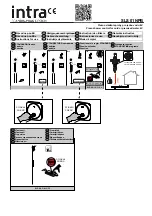
6
Failure to follow these instructions will unnecessarily increase the risk of serious falls by residents, caregivers, or
third parties caused by the chair unintentionally moving.
2.5.5
Re-Positioning of Resident - “Danger of Clamping”
Broda chairs offer the benefits of seat tilt, back recline, leg rest/footrest elevation, and moveable arms. During the
movement of any of these functions, the following safety measures must be observed:
1)
The resident’s arms must be positioned on the armrests or inside the chair frame with their hands
on their body or on.
2)
The resident’s feet must be correctly positioned on the footrest.
3)
All of the chair’s brakes have been applied.
4)
Only one caregiver at a time attempts to operate the chair’s functions.
5)
Only one chair function is operated at a time.
6)
The rear wheels are in the trailing position, behind the chair frame.
7)
The residents’ and caregivers’ body are clear of all pinch points before operating the chair’s
functions.
Failure to follow these safety measures can put the residents’ or caregivers’ limbs at risk of injury. Residents who
may be unaware of their body position or unable to maintain a safe body position are at the most risk of the danger
from clamping and caregivers should be more cautious with these residents. A second caregiver may be required to
ensure the safety of these residents during these operations.
2.5.6
Unintended Movement - “Danger of Falling or Collision”
We recommend Broda chairs for indoor use within a long-term care institution and where there is not enough slope
to cause the chairs to move unaided. Chairs used where the surface is uneven or sloped are at risk of unintended
movement and could become a serious danger to the resident, caregiver(s), or a third party. We recommend that
Broda chairs are located away from stairwells, elevators, and exterior doorways within a long-term care institution.
2.5.7
Improper Restraint Use - “Risk of Serious Injury”
We recommend that alternatives to physical restraints be used with residents while seated in the chair except under
the specific instructions of the resident’s primary caregiver and with permission of the resident’s family or guardian.
2.6
Improper Use
As outlined, the improper use of the chair is dangerous to the resident, caregivers, or third parties, and can consist of,
but is not limited to the following:
1)
Unauthorized operation of the chair’s functions.
2)
Unauthorized movement of the chair.
3)
Inappropriate use of the chair for a resident who has not been assessed by a qualified caregiver
responsible for their seating.
4)
Failure to frequently reposition the resident in the chair
5)
Attempting to operate of multiple chair functions simultaneously by one or more caregivers.
6)
Attempting to move the chair with the brake(s) applied.
7)
Leaving the resident unattended in the chair near other objects.
8)
Leaving an agitated resident in the chair in an unsupervised area.
9)
Leaving a resident unattended.
10)
Leaving a resident in a chair on a sloping surface.
11)
Leaving a chair unattended on a sloping surface.
12)
Using non-Broda accessories on the chair.
13)
Using the chair at temperatures below 0ºC.
14)
Using the chair for any use other than its intended purpose.









































